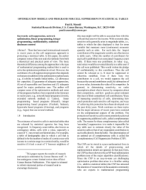
An official website of the United States government
Here’s how you know
Official websites use .gov
A .gov website belongs to an official government organization in the United States.
Secure .gov websites use HTTPS
A lock (
) or https:// means you’ve safely connected to the .gov website. Share sensitive information only on official, secure websites.
-
//
- Census.gov /
- Library /
- Census Working Papers /
- Optimization Models and Programs for Cell Suppression
Optimization Models and Programs for Cell Suppression in Statistical Tables
Optimization Models and Programs for Cell Suppression in Statistical Tables
Abstract
There has been much international research in recent years on the cell suppression approach to protecting a statistical table. In this paper, the author compares some of the new and old methods from both a theoretical and practical point of view. The basic theoretical difference among the approaches is the type of mathematical programming method that is used to solve the optimization problem involved. However, the usefulness of a cell suppression program often depends on features in addition to the optimization method used; e.g., (1) ability to handle linked tables, (2) allowance for capacities, (3) guarantee of adequate suppression, (4) set of expressible cost functions and (5) adequate speed for major production runs. The author will compare some of the optimization methods and some of the programs that have been reported in the literature in recent years; e.g., network based programs (Jewett), extended network methods (J. Castro), linear programming based programs (Massell), integer programming based programs (Fischetti, Salazar), hypercube based programs (Giessing), and programs (e.g., Argus) that use several methods.
Share
Related Information
Some content on this site is available in several different electronic formats. Some of the files may require a plug-in or additional software to view.
 Yes
Yes
 No
NoComments or suggestions?


Top

